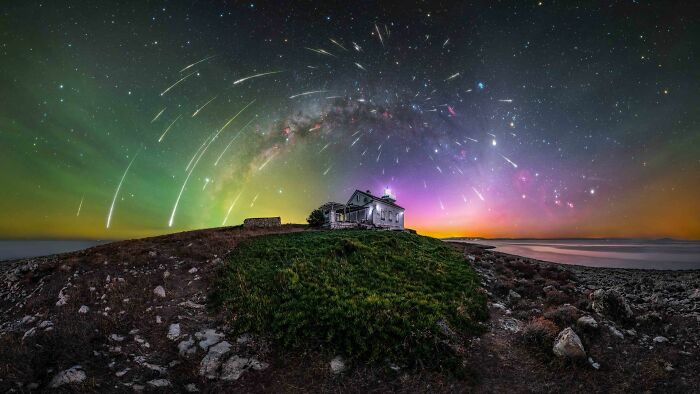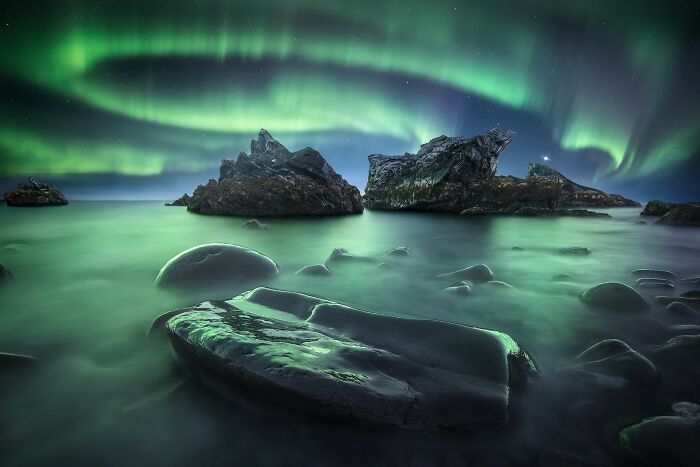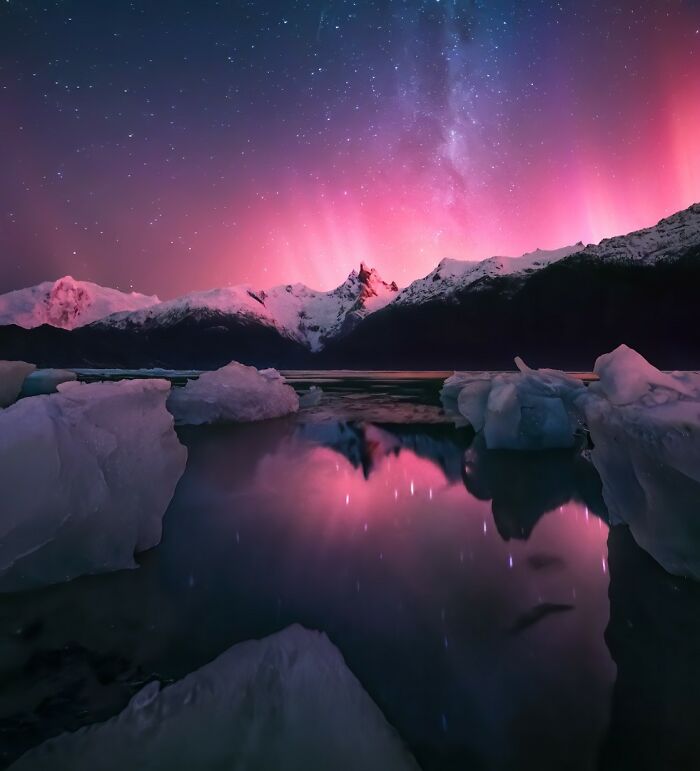The photos were taken around the world, in countries like the UK, the United States, Canada, Germany, France, Italy, Spain, Portugal, Croatia, Latvia, Iceland, Russia, Chile, Namibia, Australia, and New Zealand, by 25 photographers of 15 different nationalities.
We invite you to immerse yourselves in the beauty of the Northern Lights brought to you closer in order to learn and discover more about one of nature’s most spectacular light shows. And for more photos, you can take a look at the previous year’s post.
More info: Instagram | Facebook | youtube.com | capturetheatlas.com
#1
“Sky Fire” – Tom Rae

Aoraki/Mt. Cook National Park, New Zealand.
“The Milky Way arches over the dramatic landscape of Aoraki Mount Cook National Park, captured during a rare G5 geomagnetic storm in May 2024. This aurora display was one of the most breathtaking sights I’ve ever witnessed—a magical evening watching the lights dance across the crystal-clear sky. The excitement was shared by everyone under the stars, as this aurora was potentially the strongest in a century.
The image features a rare SAR (Stable Auroral Red) arc, an atmospheric phenomenon that added to the spectacle, alongside the glow of billions of stars in the Milky Way. Capturing this moment was technically challenging, but it resulted in one of the most unique depictions of the aurora from New Zealand. This photograph is not just an image but a treasured memory of an extraordinary and ethereal night.”
#2
“When The Aurora Meets The Milky Way” – Jānis Paļulis

Bauska, Latvia.
“On that night, I had originally planned to photograph the Perseid meteor shower, but the aurora forecast also looked promising, though it wasn’t my main focus at the time. I took a few photos of the stars, and then I noticed a pink glow in the corner of the sky. It was the aurora! I pointed my camera toward the southwest and took my best shot. The weather conditions were perfect, with fog adding to the atmosphere. Around midnight, the aurora display became truly stunning.”
#3
“Cosmic Explosion” – Uroš Fink

Istria, Croatia.
“On the night of the Perseid meteor shower, I was treated to a “multi-course menu” of the night sky. I captured the Milky Way arch with Orion, the Aurora (a first for me), the Zodiacal light, and the Perseid meteors. As if that wasn’t enough, the sky gifted me with one of the most stunning greenish airglows I’ve ever seen. Oh, and I almost forgot to mention the close conjunction of Jupiter and Mars, right along the path of the Zodiacal light.
In the center of the panorama is the Cap Marlera lighthouse, built in 1880 at the southeastern tip of the Istrian Peninsula. The rugged coastline, at the entrance to Kvarner, attracts fish and dolphins. This area is also home to the Mediterranean bear, though I didn’t have the pleasure of meeting one.
Meteors rained down throughout the night, and I captured 75 of them using three cameras. I used the RegiStar software to seamlessly insert the meteors to the panorama in the exactly same spots as they appeared in the sky this night.
It was an extraordinary, perhaps once-in-a-lifetime event, and I’m grateful and happy to have been part of it.”
#4
“In The Rays Of The Solar Wind” – Sergey Korolev

Rybachy Peninsula, Russia.
“The Rybachy Peninsula, where this photo was taken, is located at the northern edge of the Kola Peninsula. It’s a unique natural area, home to many fascinating locations with numerous stone beaches and rocks featuring unusual shapes and structures. I fell in love with this place during my first visit 10 years ago, and now, every year, I try to return and capture something new.
For this shot, I wanted to create a concept that emphasized the significance of the location, with the Northern Lights serving as a complement to the landscape. This time, the aurora was particularly powerful, casting a beautiful light over the stones. The photo is quite simple, composed of three main exposures: the first for capturing the sky, the second for the rest of the scene, and the third for focusing on the foreground.”
#5
“Aurora Australis” – Marc Adamus

Patagonia Fjords, Chile.
“I’m not sure if an aurora had ever been recorded in Patagonia before, but we got incredibly lucky on the night of May 10, 2024, when a G5 storm hit. We were camped on an iceberg beach, deep in the wilderness of the Patagonia Fjords, when the incredible display unfolded.”


